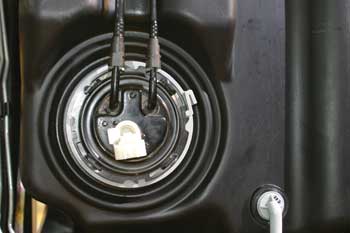How long should a fuel pump last? The carmakers tell us their original equipment pumps should last at least 150,000 miles or more. Some pumps last as long as the car itself but most have to be replaced sooner or later for a variety of reasons.
 Sometimes, a perfectly good fuel pump that still has many years of service left in it will stop working because of an electrical fault. Maybe the fuel pump relay failed, or the fuse blew. Maybe the wiring harness that connects the fuel pump at the fuel tank worked itself loose or became corroded or shorted out. Maybe the anti-theft system, PCM or other control module is preventing the pump from running for some reason (wrong key code, module miscommunication or a module failure). In situations like these, your customer doesn’t need a new fuel pump. They need to diagnose and repair the electrical fault that is preventing the pump from running.
Sometimes, a perfectly good fuel pump that still has many years of service left in it will stop working because of an electrical fault. Maybe the fuel pump relay failed, or the fuse blew. Maybe the wiring harness that connects the fuel pump at the fuel tank worked itself loose or became corroded or shorted out. Maybe the anti-theft system, PCM or other control module is preventing the pump from running for some reason (wrong key code, module miscommunication or a module failure). In situations like these, your customer doesn’t need a new fuel pump. They need to diagnose and repair the electrical fault that is preventing the pump from running.
Sometimes a fuel pump will stop working because it has literally worn itself out (worn brushes or bushings). An aging pump may become noticeably louder as it nears the end of the road. This is more typical of roller vane fuel pumps than turbine style pumps (which are typically much quieter).
Rust or debris inside the fuel tank can kill a good pump. Rust is a common problem with older, high-mileage vehicles that have steel fuel tanks. Plastic tanks in newer vehicles don’t rust, but after eight to 10 years of service, some plastics start to break down and may shed flakes of material that can clog or damage the pump.
All fuel pumps have a filter sock or screen on the pickup tube to prevent larger pieces of debris inside the tank from being drawn into the pump. But the screen can become clogged and starve the pump for fuel, causing a loss of fuel pressure or damage to the pump.
Fuel pumps use the fuel that passes through the pump for both cooling and lubrication. Consequently, if the pump runs dry either because of a plugged filter sock or because the motorist ran out of gas, the pump can self-destruct rather quickly.
Fuel pump failures that result from normal wear over time are just a consequence of driving. Replacing the pump should fix the problem and restore your customer’s mobility. The fuel pump inlet screen should also be replaced at the same time, and a new fuel filter installed. Many late-model vehicles with returnless EFI systems do not have an in-line fuel filter, but have a “lifetime” filter as part of the in-tank fuel pump assembly. If your customer is replacing the entire fuel pump module assembly, a new filter will be part of the package. But if a customer is only replacing the pump, he may be in for trouble down the road if the old filter is not replaced.
All fuel lines and hoses that are part of the fuel system should be inspected and replaced as needed. If the vehicle is more than 10 years old, new rubber fuel hoses are recommended.
The old fuel pump, fuel filter and inside of the fuel tank should also be inspected when changing a pump to make sure there are no contaminants lurking in the system that might cause a repeat failure. If an old steel tank is rusty inside, it needs to be replaced. Same for a plastic tank that is starting to break down and shed.
Finally, make sure the replacement pump is the correct one for the application. For example, GM Flex Fuel vehicles may require a different pump than those for a non-flex fuel application. On pickup trucks with dual tanks, you need to know if the pump is a transfer pump or the main pump.
Some replacement pumps may not look exactly the same as the original because some fuel pump suppliers have replaced older designs with newer, more efficient turbine pumps to consolidate SKUs. The appearance doesn’t matter as long as the replacement pump meets the vehicle manufacturers pressure and flow specifications.












